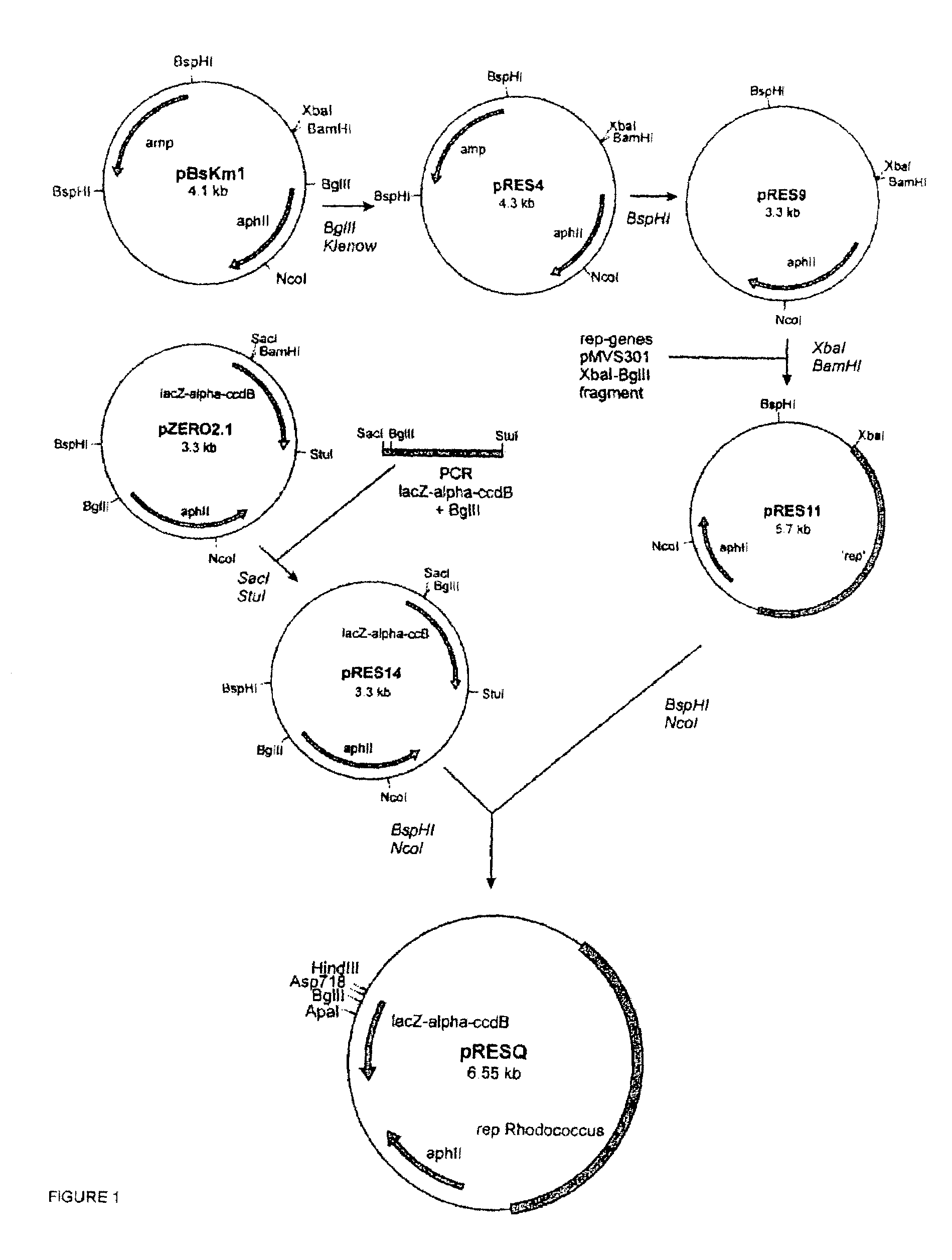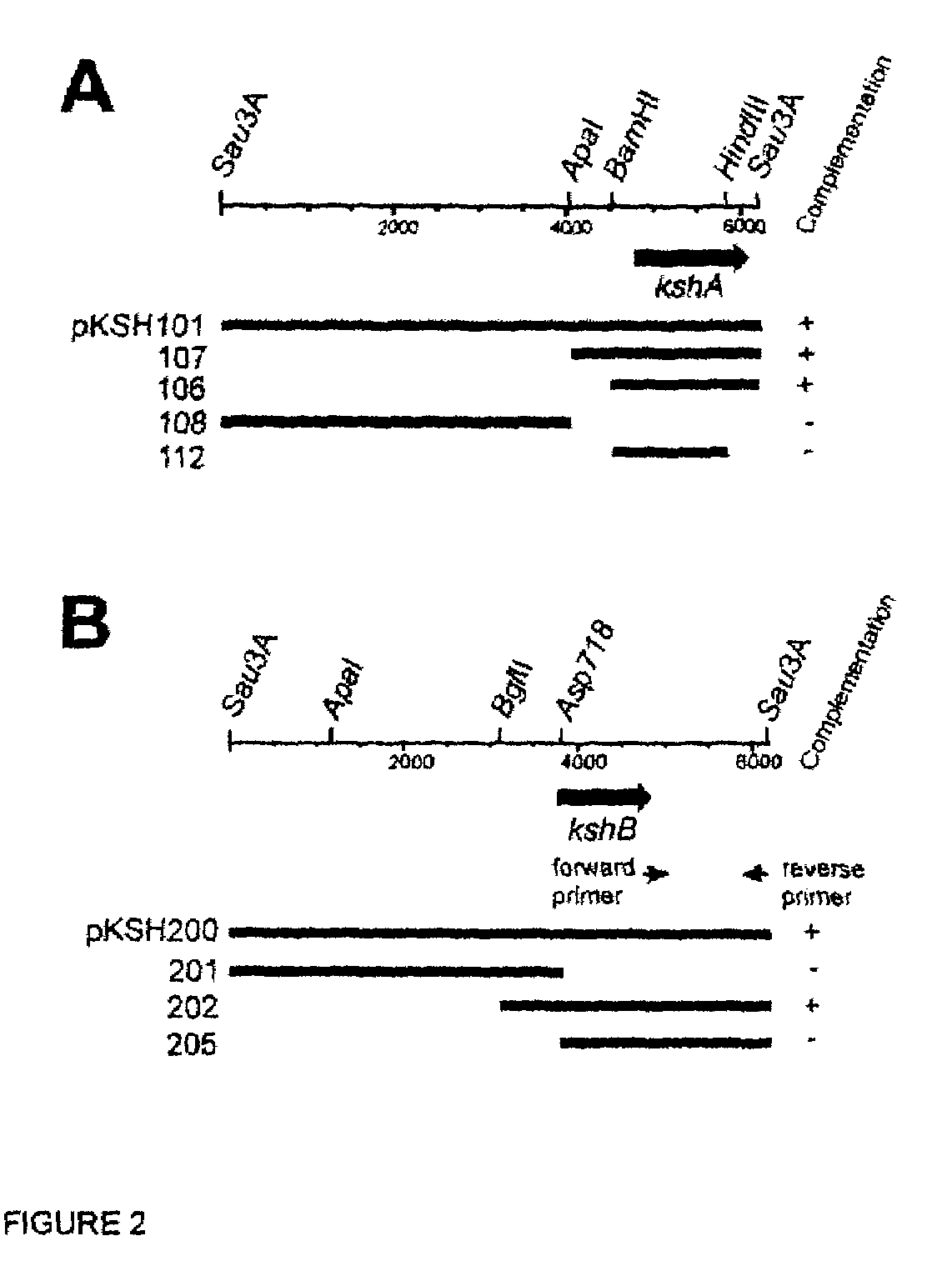Indentification of 3-ketosteroid 9-alfa-hydroxylase genes and microorganisms blocked in 3-ketosteroid 9-alfa-hydroxylase activity
a technology of 3-ketosteroid 9-alfa-hydroxylase and indentification, which is applied in the direction of biochemistry apparatus and processes, enzyme purification procedures, sugar derivatives, etc., can solve the problems of lack of genetic data, hampered the construction of molecularly defined mutant strains, and strains usually are inadequate in industrial processes
- Summary
- Abstract
- Description
- Claims
- Application Information
AI Technical Summary
Benefits of technology
Problems solved by technology
Method used
Image
Examples
example 1
Inactivation of Steroid 9α-Hydroxylase Activity by UV Mutagenesis.
[0049]Late exponential phase R. erythropolis RG1 (=kstD mutant) cells (2·108 CFUs·ml−1) grown in 10 mM glucose mineral medium were sonicated for a short period of time to obtain single cells. Diluted (104) samples were spread on glucose mineral agar medium and irradiated for 15-20 sec with a UV lamp (Philips TAW 15W) at a distance of 27 cm, on average resulting in 95% killing of cells. After 4 days of incubation, colonies that had appeared were replica plated on AD (0.5 g·l−1 solubilized in DMSO (50 mg·ml−1)) mineral agar medium. A screening for AD(D) growth deficient mutants of R. erythropolis RG1 able to grow on 9OHAD mineral medium yielded 2 mutants that were clearly impaired in the KSH reaction. These mutants, designated strain RG1-UV26 and strain RG1-UV39, showed no growth after 3-4 days with either AD or ADD as sole carbon and energy source, while growth on 9OHAD mineral agar medium was normal.
example 2
Cloning and Molecular Characterization of kshA and kshB.
[0050]The R. erythropolis strain RG1 gene library was introduced into strain RG1-UV39 by electrotransformation to complement its mutant phenotype (FIG. 2). A clone was isolated containing a 6 kb insert (pKSH101) that was able to restore growth of strain RG1-UV39 on AD mineral agar medium. Restriction enzyme mapping analysis, subcloning in pRESQ and subsequent complementation experiments resulted in identification of a 1.8 kb BamHI-Sau3A DNA fragment (pKSH106) that was still able to complement strain RG1-UV39 (FIG. 2). This 1.8 kb insert was cloned into pBlueScript (II) KS and its nucleotide sequence determined. Nucleotide sequence analysis revealed a single 1,197 nt ORF (kshA, 499-1695 of SEQ ID NO:1) encoding a putative protein of 398 aa (KshA).
[0051]Complementation of R. erythropolis RG1-UV26 with the strain RG1 gene library resulted in isolation of clone pKSH200 able to restore growth of strain RG1-UV26 on AD mineral agar me...
example 3
Unmarked Gene Deletion of kshA in R. erythropolis SQ1.
[0052]For unmarked in-frame gene deletion of kshA (ΔkshA) pKSH126 was constructed. A 1.3 kb fragment (PCR product 1) was obtained from pKSH101 using a primer (FIG. 3 primer 1) annealing to sequences upstream of kshA (5′CGCGGGCCCATCGAGAGCACGTT 3′, SEQ ID NO:5), and a primer (FIG. 3 primer 2) annealing to the 5′-end of the kshA gene (5′GCGCCCGGGTCCGAGTGCCATGTCTTC 3′, SEQ ID NO:6) containing a SmaI site (underlined). Primers for PCR product 2 were developed using the nucleotide sequence of the merged sequences of strain SQ1 and strain TA421 (DDBJ / EMBL / GenBank accession no. D88013). PCR product 2 (840 bp) was obtained from SQ1 chromosomal DNA using forward primer (FIG. 3 primer 3) annealing to the 3′ end of the kshA gene (5′ GCGCCCGGGACAACCTCCTGATTCGCAGTC 3′, SEQ ID NO:7), including a SmaI restriction site (underlined), and reverse primer (FIG. 3 primer 4) annealing to ORF11 (5′ GCGTCTAGAGTGGAAGAGCATTCCCTCGCA 3′, SEQ ID NO:8), includ...
PUM
| Property | Measurement | Unit |
|---|---|---|
| temperature | aaaaa | aaaaa |
| temperature | aaaaa | aaaaa |
| temperature | aaaaa | aaaaa |
Abstract
Description
Claims
Application Information
 Login to view more
Login to view more - R&D Engineer
- R&D Manager
- IP Professional
- Industry Leading Data Capabilities
- Powerful AI technology
- Patent DNA Extraction
Browse by: Latest US Patents, China's latest patents, Technical Efficacy Thesaurus, Application Domain, Technology Topic.
© 2024 PatSnap. All rights reserved.Legal|Privacy policy|Modern Slavery Act Transparency Statement|Sitemap



